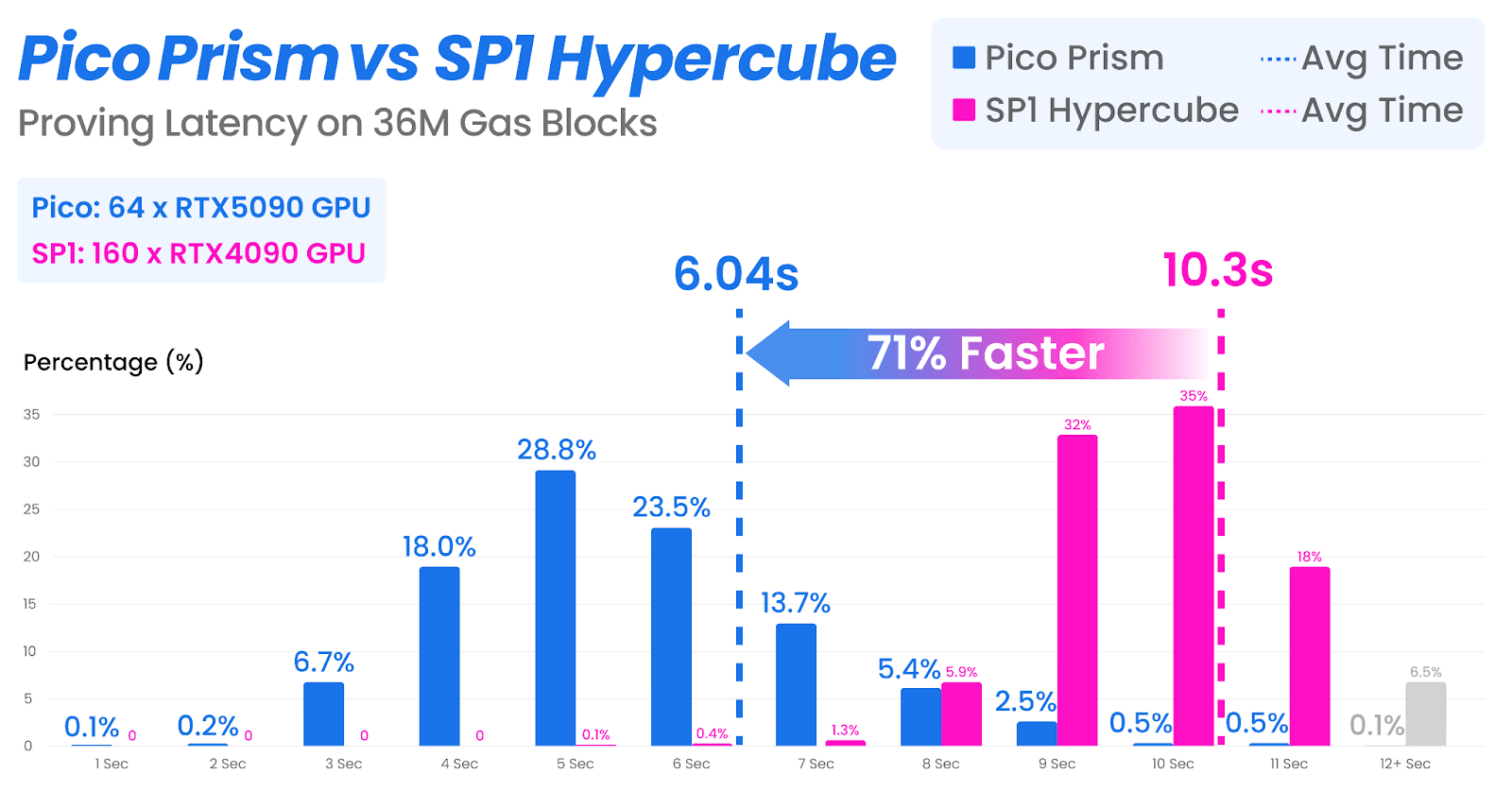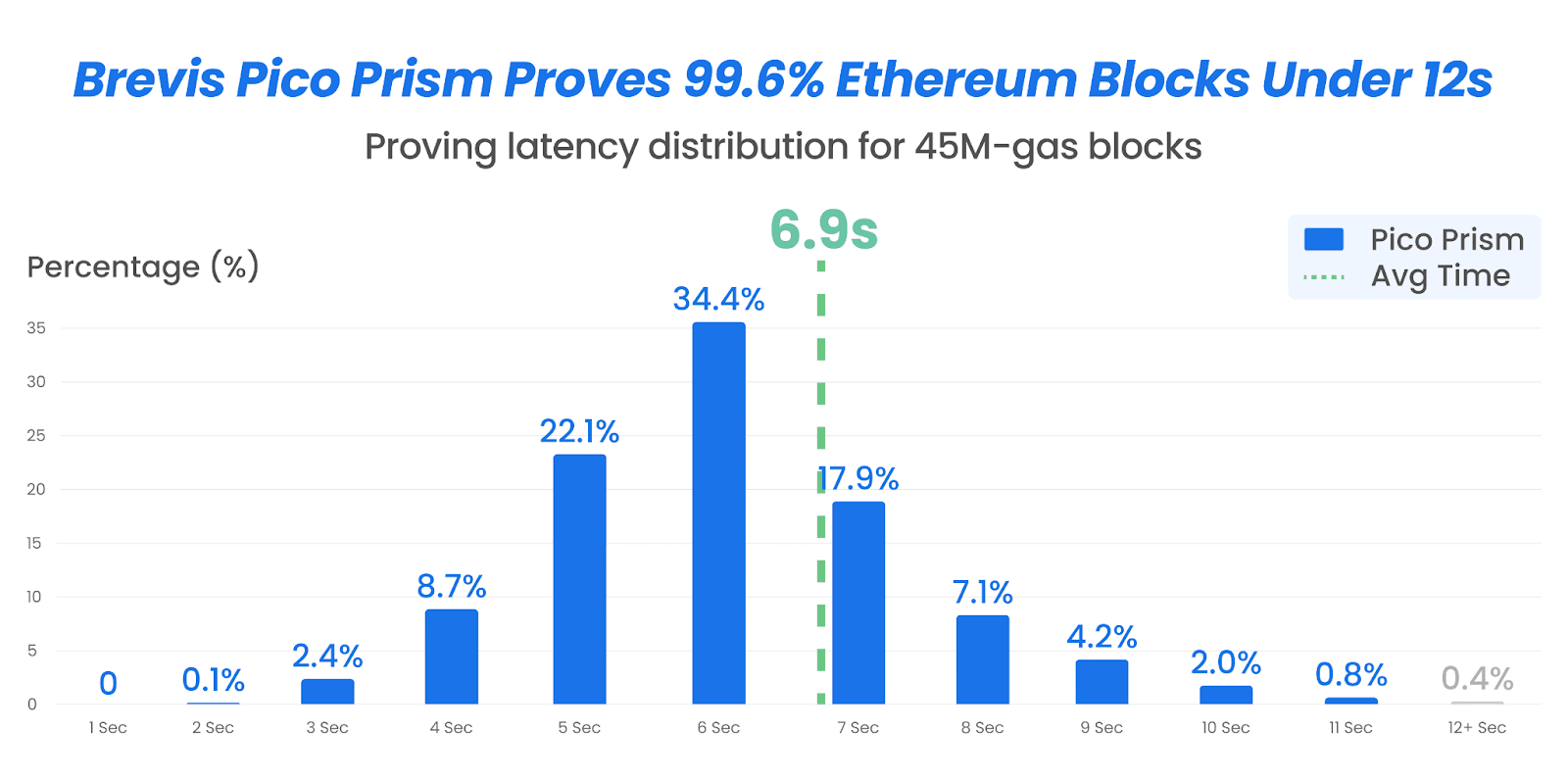Leading zero-knowledge proof infrastructure provider Brevis announced on October 15 that its Pico Prism has achieved 99.6% real-time proof coverage (within 12 seconds) and 96.8% coverage within 10 seconds for the current Ethereum mainnet block (45M Gas limit) on consumer-grade hardware.
This breakthrough indicates that real-time proof can be achieved using the accessible RTX 5090 GPU without the need for expensive data center equipment, making the technology economically viable for broader deployment while supporting Ethereum's decentralization goals.
Performance exceeds previous solutions

When tested at the same 36M Gas limit as previous benchmarks, Pico Prism significantly outperformed in all metrics:
<10 seconds coverage: 98.9% compared to 40.9% (141% improvement)
Hardware cost: $128,000 compared to $256,000 (50% reduction)
Average proof time: 6.04 seconds compared to 10.3 seconds (71% faster)
GPU requirement: 64 RTX 5090 compared to 160 RTX 4090 (60% reduction)
Performance efficiency (speed and cost combined): 3.4 times improvement
For Ethereum 45M Gas Limit, Pico Prism achieved:
99.6% coverage (within 12 seconds)
96.8% coverage (within 10 seconds)
Average proof time 6.9 seconds

Brevis co-founder and CEO Michael stated: "The data speaks for itself. We have built infrastructure capable of handling the current Ethereum block production volume, using consumer-grade hardware aimed at a broad user base. This performance perfectly aligns with Ethereum's decentralization goals."
Technical innovation: Distributed architecture
The outstanding performance of Pico Prism stems from a complete architectural reconstruction from single-machine proof to distributed multi-GPU cluster. The system utilizes Pico's modular design to allocate compute-intensive tasks to GPUs for parallel processing while the CPU is responsible for setting tasks. Through highly parallelized pipelines, maximum utilization of GPUs in the cluster is achieved, and multi-machine scaling accelerates almost linearly, resulting in excellent hardware efficiency on RTX 5090 consumer-grade hardware, offering advantages over solutions requiring expensive or dedicated data center equipment.
Advancing Ethereum scalability vision
Traditional Ethereum transactions require over 800,000 validators worldwide to independently recalculate. Pico Prism achieves scalable verification through cryptographic proofs—where a single prover generates the mathematical proof, and the remaining validators complete the verification in milliseconds.
In July 2025, the Ethereum Foundation proposed a real-time proof target in its roadmap: 99% coverage, completion within 10 seconds, hardware costing less than $100,000, and power consumption below 10kW. Pico Prism's achievements on consumer hardware are an important step towards this goal. The hardware cost of $128,000 is slightly above $100,000, but widely available consumer-grade GPUs significantly enhance accessibility.
Reproducible benchmark tests
Brevis conducted benchmark tests on Pico Prism using 8 servers (each equipped with 8 RTX 5090 GPUs, totaling 64 GPUs) and compared it with previous state-of-the-art solutions. All tests are reproducible, and all parties are welcome to verify the experimental results. Brevis is committed to promoting open, reproducible benchmark tests to support the transparency and technical excellence of Ethereum.
Production-ready infrastructure
Pico Prism is the distributed, multi-GPU evolution of the Brevis Pico zkVM architecture. Brevis has validated its zero-knowledge infrastructure in production environments through ZK Data Coprocessor technology, currently providing verifiable compute support for major DeFi protocols like PancakeSwap, Usual, Frax, Linea, and MetaMask. In the coming months, Pico Prism plans to achieve 99% real-time proof on fewer than 16 RTX 5090 GPUs, further approaching the Ethereum Foundation's goals.
About Brevis
Brevis is an efficient and verifiable off-chain compute engine that provides unlimited computing power for existing smart contract blockchains. Through zero-knowledge proofs, Brevis offloads data-intensive, high-cost computation from on-chain to low-cost off-chain engines, enabling Web3 applications to scale seamlessly while maintaining L1 security trust.
Website| Blog| Telegram| Twitter| Github| Discord
